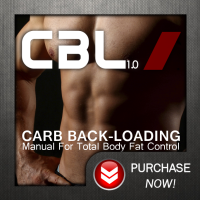What does it mean to do Carb Back-Loading™ “wrong”?
We asked SJ (Sam Joy), a serious lifter and coach over at The Yard, to relate his experiences using Carb Back-Loading in the months that followed his original write-up back in April of this year.
What he sent back details a fascinating run from an impressive kickoff to a bit of a fumble. SJ’s particular brand of failure with Carb Back-Loading should illustrate the danger of trying to second-guess this protocol, and hopefully help every carb backloader avoid a similar fate.
So, here is the heartfelt (and amusing) story of one man’s love of doughnuts, and where it all went wrong.
On Success, Failure, and Doughnuts
Earlier this year there was an uproar on one of my favorite powerlifting sites. Someone named Kiefer claimed everything everyone knew about eating was wrong, and that the exact opposite of what we all thought was right, was correct. Some were intrigued, most were pissed and spewed hateful misinformed ideas about what was common knowledge and the fact that this knowledge was correct because it was so common. Fortunately, Kiefer is not a nice guy, and also some kind of scientist, so he literally dropped science all over those fools.
Needless to say I was intrigued. Carb Back-Loading seemed too good to be true. I could eat doughnuts and get jacked, and lose fat!? Every bodybuilding and fitness magazine claims to have cracked this code, of muscle gain and fat loss, in every issue. But theirs never work. I’d tried them, and other popular “perfect diets.”
Kiefer’s was different, though. Everything he was saying went against conventional wisdom: Skip breakfast, load carbs at night, eat the refined carbs. Plus, lifters I respected and envied were already working with Kiefer. They were getting leaner and stronger and loading up on M&M’s every night. Also Kiefer had all this science and experience backing him up, which everyone with access to Wikipedia does these days; but Kiefer, being a physicist, has the skill-set required to distinguish which research is relevant and legitimate.
So it was on; I was sold and had to give this a try. Back-Loading’s forte seemed to be body recomposition, which was exactly what I was looking for after a winter bulk. I had to piece together as best I could all of Kiefer’s writings to figure out what this “Back-Loading” consisted of (and in the process I inadvertently pieced together a sort of table of contents for Kiefer’s work available here). The following is what happened with what I pieced together.
My Experience With Back-Loading Carbs
It took me a couple of months to dial this in. I am not a nutritionist, or a physicist, so trial and error was the name of the game. The first two months or so were spent reading anything I could find of Kiefer’s, applying it, applying it again, reading again, and looking for changes in body composition.
The funny thing is, even when doing it wrong, I was typically waking up looking leaner, and feeling harder, than the previous day.
What was I doing wrong? Eating rice, pasta, or bread for my 30g of carbs pre-workout, putting milk in my coffee instead of cream, and taking leucine with every meal rather than just post workout to name a few (I actually did this last one wrong the entire time).
When I finally dialed it in, a typical day looked like this:
- On rising: 30oz water, Coffee with heavy cream.
- Breakfast: (2-4hrs later) Cottage Cheese with blueberries and Coconut Oil
- Lunch: Greek yogurt with blueberries and coconut oil OR eggs cooked in coconut oil
- Pre Workout: Coffee and Creatine
- Intra-Workout: Watered down Gatorade with Creatine
- Post Workout: Chocolate Milk (2%) With Creatine
- Dinner: Chicken cooked in coconut oil, lots of rice or pasta
- Carb Load: Usually doughnuts, sometimes chocolate chip cookies or Oreos.
The carb load was pre-dinner as often as it was post dinner, and I didn’t notice much of a difference the next morning. What I did notice was not taking in enough carbs either led to unwanted weight loss or feeling “deflated” the next morning.
Also, on this note, I had a tough time eating too many carbs, but did notice on occasion when my carb load carried on past 9pm I felt I looked a little softer the next day. I should probably also mention my training at the time was the typical Westside 4 day split and I back loaded the same on my off days as on training days.
The big plus, aside from the re-composition I was seeking, was my performance in the weight room. I’m what I would call a hobbyist power lifter. I take it very seriously, but have not competed yet because I will not win. If I’m going to compete in something I need to pose a threat to my opposition. I will continue to prepare until I am a threatening force and at that point, will step onto the platform.
That being said, little to no carbs pre-workout was the best thing I’ve ever done for my pre-workout nutrition. Not only was the “fight or flight” adrenaline rush amplified times a million [see also Kiefer’s article “The Hulk Factor” –Ed], but my numbers continued to climb, my veins were popping out, and I NEVER felt like puking. Try not puking after some sled work with a pre-workout carb load. Won’t happen.
Where I really went wrong
After one month on the “dialed in” version I was looking lean and feeling strong. My abs were starting to poke through, and I was losing fat at a ridiculous rate. The issue was, pounds started to come off too. And I accelerated the process by dialing back my carb load so I could get that ripped six pack.
I don’t know what I was thinking. Through the second “dialed in” “reduced carb load” month I rationalized every pound of bodyweight lost, and every drop in my strength numbers. I don’t know why I didn’t take the hint.
I was starving in the mornings and started eating breakfast again like a regular person. That was almost 2 months ago now. Since then I’ve been sticking to a mostly very clean, very average diet. Needless to say I’ve bloated up a little bit.
The funny thing is, without even thinking about it I’ve been drifting back into Back-Loading carbs. Breakfast has slid to just about 3 hours after I wake up, and I don’t even want anything other than protein and fat until later in the day.
Currently I’ve resurrected the numbers on my lifts and am gearing up for another round of Back-Loading. What I’ll be doing differently this time is investing in a good protein supplement (to be strict about hitting at least 1g per lb of bodyweight), supplementing with leucine with post workout meals only, definitely involving coconut oil, staying low carb on appropriate off days, and keeping the carb load high enough to avoid compromise on bodyweight and strength.
Big thanks to Kiefer for consistently putting out such valuable information through dangerouslyhardcore.com and allowing me the chance to type-a-rhea all over DH.
SJ, otherwise known as Sam Joy, is a Certified Strength and Conditioning Specialist (CSCS). SJ lives and breathes fitness, and loses sleep at night thinking about bettering his own conditioning, and moreso, that of the athletes that train @theYard.








Recent Comments